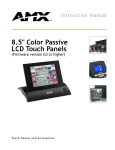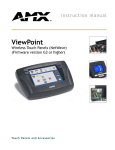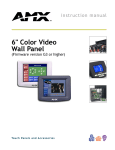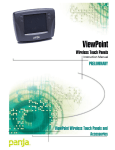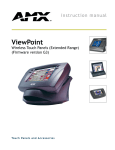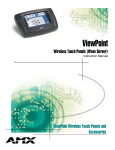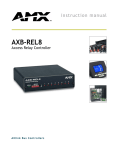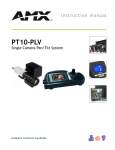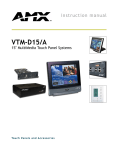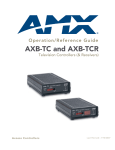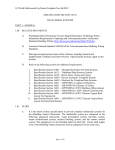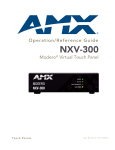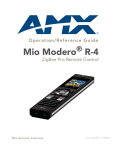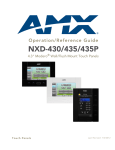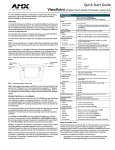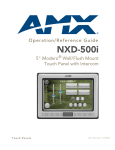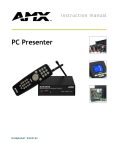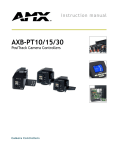Download AMX AXP-PLV POSITRACK PILOT VIDEO TOUCH PANEL Instruction manual
Transcript
instruction manual
AXP-PLV
PosiTrack Pilot Video Camera Controller
C a m e ra C o n t r o l S y s t e m s
AMX Limited Warranty and Disclaimer
AMX Corporation warrants its products to be free of defects in material and workmanship under normal use for
three (3) years from the date of purchase from AMX Corporation, with the following exceptions:
•
Electroluminescent and LCD Control Panels are warranted for three (3) years, except for the display and touch
overlay components that are warranted for a period of one (1) year.
•
Disk drive mechanisms, pan/tilt heads, power supplies, MX Series products, and KC Series products are
warranted for a period of one (1) year.
•
Unless otherwise specified, OEM and custom products are warranted for a period of one (1) year.
•
Software is warranted for a period of ninety (90) days.
•
Batteries and incandescent lamps are not covered under the warranty.
This warranty extends only to products purchased directly from AMX Corporation or an Authorized AMX Dealer.
AMX Corporation is not liable for any damages caused by its products or for the failure of its products to perform.
This includes any lost profits, lost savings, incidental damages, or consequential damages. AMX Corporation is not
liable for any claim made by a third party or by an AMX Dealer for a third party.
This limitation of liability applies whether damages are sought, or a claim is made, under this warranty or as a tort
claim (including negligence and strict product liability), a contract claim, or any other claim. This limitation of
liability cannot be waived or amended by any person. This limitation of liability will be effective even if AMX
Corporation or an authorized representative of AMX Corporation has been advised of the possibility of any such
damages. This limitation of liability, however, will not apply to claims for personal injury.
Some states do not allow a limitation of how long an implied warranty last. Some states do not allow the limitation or
exclusion of incidental or consequential damages for consumer products. In such states, the limitation or exclusion of
the Limited Warranty may not apply. This Limited Warranty gives the owner specific legal rights. The owner may
also have other rights that vary from state to state. The owner is advised to consult applicable state laws for full
determination of rights.
EXCEPT AS EXPRESSLY SET FORTH IN THIS WARRANTY, AMX CORPORATION MAKES NO
OTHER WARRANTIES, EXPRESSED OR IMPLIED, INCLUDING ANY IMPLIED WARRANTIES OF
MERCHANTABILITY OR FITNESS FOR A PARTICULAR PURPOSE. AMX CORPORATION
EXPRESSLY DISCLAIMS ALL WARRANTIES NOT STATED IN THIS LIMITED WARRANTY. ANY
IMPLIED WARRANTIES THAT MAY BE IMPOSED BY LAW ARE LIMITED TO THE TERMS OF THIS
LIMITED WARRANTY.
Table of Contents
Table of Contents
Introduction ...............................................................................................................1
Specifications .................................................................................................................... 1
Product Components......................................................................................................... 2
Sample Product Application .............................................................................................. 3
Installation .................................................................................................................5
Inside the AXP-PLV........................................................................................................... 5
Setting the AXlink Device Numbers .................................................................................. 5
Wiring the AXP-PLV .......................................................................................................... 6
Wiring guidelines...................................................................................................................... 6
Using the mini-XLR connector for AXlink data and power ....................................................... 7
Using the mini-XLR connector with an external 12 VDC power supply ................................... 7
Using a BNC video cable to provide video input ...................................................................... 7
Designing Touch Panel Pages ................................................................................9
Buttons .............................................................................................................................. 9
Activating Edit Mode........................................................................................................ 10
Setting the Device Base .................................................................................................. 12
Setting the Device Used.................................................................................................. 12
Adding a Page................................................................................................................. 12
Setting the page color ............................................................................................................ 12
Adding a Button............................................................................................................... 13
Resizing a button ................................................................................................................... 13
Defining On-Screen and External Button Properties....................................................... 13
Setting the channel code........................................................................................................ 14
Setting the variable text code................................................................................................. 14
Setting the page flip ............................................................................................................... 14
Setting the button colors for channel-off conditions ............................................................... 15
Adding text, icons, and bitmaps to a button ........................................................................... 15
Using TPDesign3 to Download Bitmaps, Icons, and Fonts............................................. 15
Creating a Bargraph and Joystick ................................................................................... 16
Adding a bargraph or joystick button\..................................................................................... 16
Setting Bargraph and Joystick Properties ....................................................................... 16
Setting the level code............................................................................................................. 17
Programming ..........................................................................................................19
Serial Commands............................................................................................................ 19
System Send_Commands............................................................................................... 20
AXP-PLV PosiTrack Pilot VIdeo Camera Controller
i
Table of Contents
Video Send_Commands ................................................................................................. 25
Programming Numbers ................................................................................................... 26
Shorthand Send_Commands.......................................................................................... 27
Color Send_Commands.................................................................................................. 31
Variable Text Send_Commands ..................................................................................... 33
Shorthand Variable Text Commands .............................................................................. 35
Button String Commands ................................................................................................ 38
Upgrading the Firmware ........................................................................................ 39
Configuration................................................................................................................... 39
Downloading the Firmware ............................................................................................. 39
ii
AXP-PLV PosiTrack Pilot Video Camera Controller
Introduction
Introduction
The AXP-PLV PosiTrack Pilot Video Panel Camera Controller (PosiPilot) is an integrated
controller for use with cameras and camera positioning devices (such as the AXB-PT10/30
PosiTrack Camera Controllers). Refer to the AXB-PT10/30 PosiTrack Camera Controllers
instruction manual for more information. The AXP-PLV connects to the camera-positioning device
and Central Controller via an AXlink connection. This connection provides control of the pan/tilt,
camera, and lens. The PosiPilot can be used in a stand-alone configuration with a Central
Controller, compatible cameras, and positioning systems, or as part of a larger AMX control
system.
The PosiPilot combines traditional dual-axis proportional-speed joystick camera controls with an
integrated Color Active Mini-Touch Panel to give you graphic touch control and on-screen video
monitoring (with video input for NTSC/PAL).
Specifications
Specifications
Dimensions (HWD)
4.97" (including joysticks) x 17.67" x 8.39" (12.61 cm x 44.89 cm x 21.30 cm)
Weight
4.90 lb (2.20 kg)
Power
540 mA
Enclosure
Plastic with matte blue finish and plastic rests
Temperature Range
0º C (32º F) to 50º C (122º F)
Power Consumption
1 A @12 VDC
Buttons
12 pushbuttons, six on each side to select cameras and access camera menus
Video monitor
6-inch (152.40 mm) color active-matrix LCD screen
Video In
BNC female connector (NTSC/PAL)
Compatibility
NetLinx/Axcess Central Controllers
Connectors
4-pin mini-XLR (female) cable (pre-assembled)
BNC (female) Video In connector (NTSC/PAL)
FIG. 1 and FIG. 2 show the dimensions for the front and side of the AXP-PLV.
FIG. 1 AXP-PLV front panel dimensions
AXP-PLV PosiTrack Pilot Video Camera Controller
1
Introduction
FIG. 2 AXP-PLV side panel dimensions
Product Components
The top of the PosiPilot is equipped with external pushbuttons, color video touch panel, and a
3-axis pan/tilt/zoom joystick. FIG. 3 gives a description of the AXP-PLV front panel components.
External
pushbuttons
Color video touch
panel for video preview
and control interface
External
pushbuttons
Pan/tilt/zoom
control joystick
FIG. 3 AXP-PLV front panel component descriptions
FIG. 4 gives a description of the side and rear components.
Pan/tilt/zoom
control joystick
Focus control
knob
Iris control
knob
Mini-XLR
(male)
BNC
(male)
Speed knob
FIG. 4 AXP-PLV side and rear component descriptions
2
AXP-PLV PosiTrack Pilot Video Camera Controller
Introduction
Sample Product Application
FIG. 5 shows a camera control application using the AXP-PLV. AMX devices used for a single
camera configuration are:
Sample Devices Used
AXB-EM232
Master Controller
AXB-PT10
Pan/Tilt Camera Head
AXP-PLV
PosiTrack Pilot Video Panel Camera Controller
PS2.8
Power Supply (for AXB-EM232)
PSN6.5
Power Supply (for AXB-PT10)
Camera
Camera Adapter
DB-9
Preview
input
AMX AXB-PT-10
2-pin captive-wire
AMX PSN6.5
Power Supply
AMX AXP-PLV
AXlink
AXlink
AMX AXB-EM232 (rear view)
AMX ABS (AXlink Bus Strip)
AXlink
2-pin captive-wire
AMX PS2.8
Power Supply
FIG. 5 AXB-PLV product application
AXP-PLV PosiTrack Pilot Video Camera Controller
3
Introduction
4
AXP-PLV PosiTrack Pilot Video Camera Controller
Installation
Installation
Inside the AXP-PLV
The AXP-PLV unit contains two discrete AXlink devices: an AXP-AI8 (eight-channel analog input
interface board) and a mini color video touch panel. The AXP-AI8 is connected to the joystick and
knob functions of the AXP-PLV and is set to a factory default of 129.
Level assignments for the AXP-AI8 inside the AXP-PLV are:
AXP-AI8 Level Assignments
Level 1
Pan (joystick)
Level 2
Tilt (joystick)
Level 3
Zoom (joystick)
Level 4
Speed (knob)
Level 5
Iris (knob)
Level 7
Focus (knob)
Refer to the AXP-AI8 Eight-Channel Analog Input Interface Board instruction manual for more
information.
Setting the AXlink Device Numbers
To change the AXP-AI8 AXlink device number:
1. Gently rotate the panel (bringing the joystick to the left) over until you can lay it down and
expose the slender opening on the underside of the unit. The slot exposes the AXlink DIP
switch on the internal AI8 circuit card) (FIG. 6).
8 76 54321
AXlink
DIP switch
(S5)
FIG. 6 AI8 AXlink DIP switch location (default set to 129)
2. Use a slender screwdriver to change the internal DIP switch positions from their default value
of 129 (FIG. 6).
The DIP switch value set on the underside of the controller is the value assigned to the internal
AI8 card (default 129). The touch panel is default set to 131. When the unit is connected to a
Central Controller and queried for its addresses, it returns a value for both the touch panel
(default 131) and the AI8 card (default 129).
3. Set the AXlink device number by changing the AXlink device DIP switch positions 1 – 8
(FIG. 6). The total value of all ON (up) positions on the DIP switch sets the device number.
The DIP switch value range is between 1 - 255, and is set according to the Device DIP switch
AXP-PLV PosiTrack Pilot Video Camera Controller
5
Installation
positions and their corresponding values. The device number takes effect only after poweringup.
Device DIP Switch Settings
Position
1
2
3
4
5
6
7
8
On value
1
2
4
8
16
32
64
128
4. Once completed, rotate the unit and lay it on a flat surface. Refer to the Setting the Device
Base section on page 12 for more information on changing the touch panel device number.
Wiring the AXP-PLV
The AXP-PLV has an AXlink four-wire mini-XLR connector (located on the rear of the AXP-PLV)
and a BNC male connector (at the rear of the unit) A female mini-XLR cable (provided) is supplied
to facilitate wiring.
Wiring guidelines
The AXP-PLV requires 12 VDC power to operate properly. The Central Controller supplies power
via the AXlink cable or external auxiliary 12 VDC power supply. The maximum wiring distance
between the Central Controller and AXP-PLV is determined by power consumption, supplied
voltage, and the wire gauge used for the cable. The Wiring Guidelines tablelists wire sizes and the
maximum lengths allowable between the camera centers and control system. The maximum wiring
lengths for using AXlink power are based on a minimum of 13.5 VDC available at the control
system’s power supply.
Wiring Guidelines
Wire size
Maximum wiring length
18 AWG
217.35 feet (66.25 m)
20 AWG
137.51 feet (41.92 m)
22 AWG
85.73 feet (26.13 m)
24 AWG
54.042 feet (16.47 m)
If you install the AXP-PLV farther away from the control system than recommended in the above
table, connect an external 12 VDC power supply to the camera controller according to the wiring
diagrams described in this section.
6
AXP-PLV PosiTrack Pilot Video Camera Controller
Installation
Using the mini-XLR connector for AXlink data and power
Wire the Central Controller’s AXlink connector to the mini-XLR connector (male) on the rear
panel of the AXP-PLV for data and 12 VDC power, as shown in FIG. 7.
Four-pin mini-XLR connector
(external view)
1 GND (-) - Black
2
1
4
3
2 AXM
- Green
3 AXP
- White
4 PWR (+) - Red
4 - PWR (+) - Red
3 - AXP
- White
2 - AXM
- Green
1 - GND (-) - Black
Central Controller
(AXCENT3 or AXB-EM232)
FIG. 7 Mini-XLR connector to control system wiring diagram
Using the mini-XLR connector with an external 12 VDC power supply
Wire the Central Controller’s AXlink connector to the mini-XLR connector and external 12 VDC
power supply. Then, connect the mini-XLR terminal connector to the rear panel of the AXP-PLV as
shown in FIG. 8.
PWR (+) - Red
GND (-) - Black
Four-pin mini-XLR connector
(external view)
1 GND (-) - Black
2
1
4
3
2 AXM
- Green
3 AXP
- White
4 PWR (+) - Red
4 - PWR (+) - Red
3 - AXP
- White
2 - AXM
- Green
1 - GND (-) - Black
Central Controller
(AXCENT3 or AXB-EM232)
FIG. 8 Mini-XLR connector to external 12 VDC power supply wiring diagram
Using a BNC video cable to provide video input
Connect the control system’s video connector to the rear of the AXP-PLV using a BNC cable to
provide a video feed, as seen in FIG. 9.
GND (-)
Video wire
BNC (female) connector
Rear panel
view AXP-PLV
BNC (male) connectors
Video source
FIG. 9 BNC cable connection from the AXP-PLV to the video source
AXP-PLV PosiTrack Pilot Video Camera Controller
7
Installation
8
AXP-PLV PosiTrack Pilot Video Camera Controller
Designing Touch Panel Pages
Designing Touch Panel Pages
There are two ways to approach creating touch panel pages:
!
TPDesign3 - Refer to the TPDesign3 Touch Panel Program (Version 3. 16) instruction
manual for more information.
!
On-board editor
This section describes the basics of using the on-board editor to create pages and buttons. For more
information, refer to the G3 Firmware Design and Reference instruction manual.
Buttons
Standard button types include rectangles and other geometric shapes you can create with the touch
panel editor. Buttons are set with attributes, meaning there is a response from the Central Controller
when you touch the button.
General buttons are part of the default touch panel program and cannot be changed. You use general
buttons to create or revise pages and specify panel communication parameters. Button examples
include selection buttons, information buttons, adjustment buttons, and operation bars. The general
button categories are described in the table below.
General Button Categories
Selection buttons
Selection buttons appear on touch panel pages and set communication parameters.
Information buttons
Information buttons contain serial numbers and firmware version
information. The properties of these buttons cannot be changed.
These buttons have a dark fill and light text.
Adjustment buttons
You can use the UP and DN buttons to set adjustment buttons. The
adjustment button example sets the baud rate for the connection
from the touch panel to the computer.
Keypad buttons
The keypad button opens a keypad so you can enter a password or
value assignment. All keypad buttons are interactive except for the
entry display.
Decision buttons
Decision buttons appear when an operation has two options and
requires verification before an action is performed.
AXP-PLV PosiTrack Pilot Video Camera Controller
9
Designing Touch Panel Pages
General Button Categories (Cont.)
Status buttons
Status buttons always have a dark fill with light letters and have no
functionality except to display information.
Operation bars
Operation bars appear in the place of the Editor bar, after selecting a
button or page edit operation. The operation bar indicates which edit
function is currently active. When an edit operation is selected, it
remains active until you press EXIT.
Touch to Continue buttons
"Touch to Continue" buttons appear when an operation requires user
acknowledgement.
Joystick buttons
Joysticks are vertical and horizontal direction controllers for use with
pan and tilt camera controllers.
Bargraph buttons
Bargraph buttons display a dynamic bargraph (vertical or horizontal).
An example is the Battery level indicator button.
Activating Edit Mode
Before designing touch panel pages and buttons, you must activate EDIT mode. Once activated, use
the EDIT button to enter Edit mode. This mode has options to add and configure touch panels and
buttons. When powering up the touch panel, the first page is the Main page (see FIG. 10). Note that
the Edit button is not available initially.
FIG. 10 Main Page
If you have a pre-programmed panel, you may not see the Main Page.
10
AXP-PLV PosiTrack Pilot Video Camera Controller
Designing Touch Panel Pages
To activate edit mode:
1. Press SETUP in the Main page to open the Setup page (FIG. 11).
FIG. 11 Setup page
2. Press PROTECTED SETUP to open the keypad.
3. Enter 1988 (default password) in the keypad and press ENTER to open Protected Setup page.
If you press ENTER after typing an incorrect password, you are immediately returned to the
previous page.
4. Press EDITOR to enable Edit mode. The EDITOR button is highlighted in the Protected Setup
page when enabled, as shown in FIG. 12.
FIG. 12 Protected Setup page with the active EDITOR button
5. Press EXIT to close the Protected Setup page and return to the Setup page (now in the Edit
mode).
6. Press EXIT again to return to the Main page. The EDIT button appears at the top of the page
indicating that Edit mode is active.
7. Press EDIT to open the Edit bar. The BUTTON and PAGE options, in the Edit bar, (FIG. 13)
are used to design and modify button and page settings.
AXP-PLV PosiTrack Pilot Video Camera Controller
11
Designing Touch Panel Pages
Edit bar
FIG. 13 Main page with Edit bar
Setting the Device Base
Press the DEVICE BASE option, in the Protected Setup page (FIG. 12), to assign a base (starting)
device address to the touch panel.
1. Enter the base address for the touch panel. The base address range is from 1 - 255. Standard
device addresses begin at 128.
2. Press Enter to save.
Setting the Device Used
Use the DEVICE USED option in the Protected Setup page (FIG. 12) to assign an initial value for
the device address range used by the touch panel.
1. Press DEVICE USED to open the keypad and enter the panel’s device number from 1 - 4. Each
device number supports up to 255 programmable channel codes. The multiple device settings
allow you to create up to four unique touch panel buttons and/or pages. This value is used to
determine the current device being used by the panel.
2. Enter the number of devices being used by the touch panel.
3. Press Enter to save the value.
If DEVICE USED is set to 4 and Base Device Number is 128, the Controller recognizes
bus devices 128 - 131.
The panel will not allow you to enter a device number greater than the DEVICE USED
without first displaying a decision box asking if you accept the new selection or not.
Adding a Page
1. Press PAGE on the Edit bar to open the PAGE menu.
2. Press ADD to open the keyboard and enter a name for the new page. Page names can be up to
20 characters.
3. Press EXIT CHANGE to save, close the keyboard, and go to the new page.
Setting the page color
1. Press EDIT to open the Edit bar on the newly created page.
2. Press PAGE on the Edit bar to open the PAGE menu.
12
AXP-PLV PosiTrack Pilot Video Camera Controller
Designing Touch Panel Pages
3. Press PAGE COLOR to open the color palette.
4. Select a color from the palette; the page automatically changes to the new color.
Adding a Button
To add a button to the current page:
1. Press BUTTON on the Edit bar to open the BUTTON menu.
2. Press ADD to open the ADD BUTTON operation bar. On the LCD screen, touch and drag to
create a button. The first touch point is the upper-left corner of the button.
Resizing a button
1. Press BUTTON on the Edit bar to open the BUTTON menu.
2. Press RESIZE. Then, touch any edge of the button and drag. Removing your finger from the
panel saves the button dimensions.
Defining On-Screen and External Button Properties
External pushbuttons are configured with features similar to on-screen buttons. Their functionality
can be set just as any other button on the touch panel.
Use the PROPERTIES option of the BUTTON menu in the Edit bar to set button borders, page
flips, button colors for channel on/off conditions, channel/variable text codes, and string/macro
assignments.
External button properties include only the button type, page flips, channel codes, and string/macro
assignments. Although the Border and Color sections of this page appear, they are of no use to
external pushbuttons since they do not appear on-screen.
Use the following steps to set button properties:
1. Press BUTTON on the Edit bar to open the BUTTON menu options.
2. Press PROPERTIES to open the PROPERTIES operation bar.
3. Press the new button to open the Button Properties page. This page lists the properties for the
active button.
4. Press BUTTON TYPE; this opens the BUTTON TYPE menu.
5. Choose a button type for the selected button to open the associated Button Properties page.
Each button type has its own Button Properties page with settings specific to the button type.
6. Press BORDER to open the BUTTON BORDER pages.
7. Select a border to set for the button and return to the Button Properties page. The BORDER
button changes to show the selected border type.
AXP-PLV PosiTrack Pilot Video Camera Controller
13
Designing Touch Panel Pages
Setting the channel code
The channel button sets the device and button channel codes.
Channel codes and variable text codes work the same for all button types, including
joysticks, and bargraphs.
1. In the Button Properties page, press DEV to open the keypad and set the touch panel’s device
number.
2. Enter 1, 2, 3, or 4 in the keypad. The programming software uses device codes 1 - 4 to identify
the touch panel. Refer to the G3 Firmware Design and Reference instruction manual for more
information.
If DEVICE USED is set to 4 and Base Device Number is 128, the Controller recognizes
bus devices 128 - 131.
The panel will not allow you to enter a device number greater than the DEVICE USED
without first displaying a decision box asking if you accept the new selection or not.
3. Press ENTER to save the device number, close the keypad, and return to the Button Properties
page.
4. Press CHAN to open the keypad and enter a channel value of 1 - 255. The source code uses the
channel code number to identify the button and its programmed operations. The channel code
for non-active buttons is 0.
5. Press ENTER to save the channel number, close the keypad, and return to the Button
Properties page.
Setting the variable text code
The variable text buttons set the device and button channel codes for the buttons.
1. Press DEV to open the keypad and set the device number.
2. Enter 1, 2, 3, or 4 in the keypad. The source code uses device codes 1 - 4 to identify the touch
panel.
3. Press ENTER to save, close the keypad, and return to the Button Properties page.
4. Press CHAN to open a keypad and set the channel number.
5. Enter a channel value of 1 - 255 in the keypad. The source code uses the channel code number
to identify the button and its operations.
6. Press ENTER to save the channel number, close the keypad, and return to the Button
Properties page.
Setting the page flip
1. Press the PAGE FLIP Type button (FIG. 14) in the Button Properties page to open the Page
Flip Type menu.
2. Select a Page Flip type. If you select FLIP PREVIOUS in the Page FLIP Type menu, the FLIP
to Page button appears.
3. Press the FLIP to Page button (FIG. 14) to open a list of all the saved touch panel pages. If the
desired page is not present in the menu, check to verify the page has been saved.
14
AXP-PLV PosiTrack Pilot Video Camera Controller
Designing Touch Panel Pages
Page FLIP type
button
Flip to Page button
FIG. 14 Page FLIP Type button
4. Select the target page for the page flip.
Setting the button colors for channel-off conditions
1. Press any button to open the Button Properties page.
2. Press BORDER under CHANNEL OFF in the Button Properties page. The color palette
appears. Select a color to set as the border.
3. Press the FILL button in the Button Properties page to open the palette. Select a color to set as
the fill.
4. Press the TEXT button to open the palette. Select a color to use for the text.
5. Press EXIT SAVE CHANGE in the Button Properties page to save the new button properties
and return to the current page.
Adding text, icons, and bitmaps to a button
1. Press BUTTON on the Edit bar to open the BUTTON menu.
2. Press TEXT/IMAGE to add text to the button. The TEXT/IMAGE operation bar appears.
3. Press any button to open the Text/Image page.
4. Go through each option and set as desired:
!
TEXT OFF and TEXT ON sets the text for the button's Off and On state.
!
ICON OFF and ICON ON sets the icon for the button's Off and On state.
!
BITMAP OFF and BITMAP ON sets the bitmap for the button's Off and On state.
!
MAKE ON SAME AS OFF sets the On and Off properties the same.
You cannot create or edit buttons with Unicode fonts on the panel. Any use of the
TEXT/IMAGE button to alter or create Unicode font supported buttons must be done
in the TPDesign3 Touch Panel Design Program.
5. Press EXIT SAVE CHANGE to close the Text/Image page and return to the Main page.
Using TPDesign3 to Download Bitmaps, Icons, and Fonts
TPDesign3 allows you to download bitmaps, icons, and fonts into your touch panel from an
existing touch panel program. Touch Panel programs are created in the TPDesign3 software
program. Refer to the TPDesign3 Touch Panel Program instruction manual for more information.
Use the Download to Panel button to download a project file.
To download bitmaps, icons and/or fonts from an existing TPDesign3 project file:
1. Launch the TPDesign3 software program and open a project file that contains the desired
bitmaps, icons, and fonts.
AXP-PLV PosiTrack Pilot Video Camera Controller
15
Designing Touch Panel Pages
2. Select File from the menu bar to open the File menu.
3. In the File menu, click on Download to Panel; this opens the Download to Panel dialog box.
4. Click on the Comm Settings tab to set the communications port, baud rate, and other
communication settings.
5. Then, click the Actions tab to set the communication mode and select which elements of the
project file you want to download to the touch panel.
6. In the What To Send area, select one or more of the available options (All Bitmaps, All Icons,
All Fonts).
7. Select the mode of communication with the touch panel (RS-232 and AXlink). Confirm that
the correct panel is selected by verifying the ID values with the Base Address assigned to the
touch panel in the Protected Setup page.
8. After clicking Connect, the Available Panels list appears in the Available Panels field. Click
Begin to start downloading the project file into the panel.
9. After completing the download, the bitmaps, icons and fonts that were downloaded are now
accessible via the BITMAPS, ICONS and FONTS menus.
Creating a Bargraph and Joystick
Bargraphs are level monitors and adjustable level controls. These levels can be configured to
monitor and adjust audio outputs and lighting levels.
Joysticks are vertical and horizontal direction controllers you can use for camera for pan and tilt
control. Before you start, make sure to connect the touch panel to your Controller; otherwise, the
joystick will not work properly.
Adding a bargraph or joystick button\
Create a new button using the ADD operation bar in the BUTTON menu.
1. Press BUTTON in the Edit bar to open the BUTTON menu.
2. Press PROPERTIES in the BUTTON menu to open the PROPERTIES operation bar.
3. Press any button to open the Button Properties page.
4. Press BUTTON TYPE to open the BUTTON TYPE menus. Choose a button type to open its
Button Properties page.
Setting Bargraph and Joystick Properties
Use the Button Properties page to set channel, level, and button colors. Refer to the Setting the
variable text code section on page 14 and the Setting the channel code section on page 14 for
further information. Refer to the Setting the button colors for channel-off conditions section on
page 15 for more information on colors for channel-off conditions.
16
AXP-PLV PosiTrack Pilot Video Camera Controller
Designing Touch Panel Pages
Setting the level code
Level buttons set the device and number codes for the touch panels.
Joysticks actually use two level numbers. The first is for the X-axis and the second is
for the Y-axis. You only need to specify the first level.
1. Press DEV to open a keypad and set the device number.
2. Enter 1, 2, 3, or 4 in the keypad. The programming software uses device codes
1 - 4 to identify the touch panel.
3. Press ENTER to save the level device number, close the keypad, and return to the Button
Properties page.
4. Press NUM to open a keypad and set the level number assigned to the device.
5. Enter a number 1 – 8. Each device can have from 1 – 8 levels except joysticks, where the range
is 1 – 7.
6. Press ENTER to save, close the keypad, and return to the Button Properties page.
AXP-PLV PosiTrack Pilot Video Camera Controller
17
Designing Touch Panel Pages
18
AXP-PLV PosiTrack Pilot Video Camera Controller
Programming
Programming
You can program the touch panel to perform a wide variety of operations using Axcess
Send_Commands and variable text commands. Use the commands described in this section to
program the touch panel. Refer to the Axcess Programming Language instruction manual for
complete information.
Serial Commands
Serial Commands are used in the AxcessX Terminal Emulator Mode. These commands are case
insensitive.
Serial Commands
?PAR
Returns panel
parameters to the
PC terminal.
Panel parameters include: firmware version, device number, mouse type, output resolution, number of devices, cursor enable, brightness, and contrast.
Syntax:
"?PAR"
Example:
"?PAR"
Requests the information.
CALIBRATE
Starts touch panel
calibration.
Syntax:
"CALIBRATE"
Example:
"CALIBRATE"
Starts the calibration sequence mode on the touch panel.
CHECK CAL
Syntax:
Enters the calibra"CHECK CAL"
tion test mode.
Example:
"CHECK CAL"
Starts the calibration check mode on the touch panel.
ECHO ON
Turns On character echo.
Syntax:
"ECHO ON"
Example:
"ECHO ON"
The character echo is sent back to the computer.
ECHO OFF
Turns Off character echo.
Syntax:
"ECHO OFF"
Example:
"ECHO OFF"
The character echo is not sent back to the computer.
HELLO
Syntax:
Verifies the serial
communication is
working properly.
Example:
"HELLO"
"HELLO"
If the communication is active and working, the response is "How are you doing?".
AXP-PLV PosiTrack Pilot Video Camera Controller
19
Programming
Serial Commands (Cont.)
SETUP
Syntax:
Goes to Setup
Page.
Example:
"SETUP"
"SETUP"
Flips the touch panel to the Setup page.
VER
Restores the current vision.
Syntax:
"VER"
Example:
"VER"
This returns the current version of the main firmware.
ZAP!
Syntax:
Clears all mem"ZAP!"
ory and erase butExample:
tons, pages,
"ZAP!"
drawings, and
symbols.
Clears all memory and erases all buttons, pages, drawings, and symbols.
System Send_Commands
System Send_Commands are stored in the Controller and direct the touch panel to perform various
operations.
System Send_Commands
ABEEP
Syntax:
Outputs one panel
"’ABEEP’"
beep even if the
Example:
beep value is set
SEND_COMMAND TP, "’ABEEP’"
to 0 in the Setup
page.
Beeps the panel.
ADBEEP
Syntax:
Outputs a double
"’ADBEEP’"
beep even if the
Example:
double beep value
SEND_COMMAND TP, "’ADBEEP’"
is set to 0 in the
Setup page.
Double beeps the panel.
AKEYB
The keyboard string is set to null during power-up and is stored until power-down.
Opens the touch
panel keyboard
and initializes the
text string entry.
Syntax:
“’AKEYB-<text string>’"
Variables:
text string = 0 - 59 characters
Example:
SEND_COMMAND TP, “’AKEYB-TOUCH HERE’"
Opens the touch panel keyboard with TOUCH HERE in the display.
20
AXP-PLV PosiTrack Pilot Video Camera Controller
Programming
System Send_Commands (Cont.)
AKEYP
The keyboard string is set to null during power-up and is stored until power-down for.
Opens the touch
panel keypad and
initializes the
number string
entry.
Syntax:
"’AKEYP-<number string>’"
Variables:
number string = 0 - 9999
Example:
SEND_COMMAND TP,"’AKEYP-1988’"
Opens the touch panel keypad with 1988 in the display.
AKEYR
Closes/opens the
touch panel keyboard/pad.
Syntax:
"’AKEYR’"
Example:
SEND_COMMAND TP,"’AKEYR’"
Closes the keyboard/keypad opened using the ’AKEYB’, ’AKEYP’, or ’PKEYP’ commands.
BEEP
The Beep button in the Protected Setup page must be set from 1 - 10 for the BEEP comGives an output of mand.
one beep.
Syntax:
"’BEEP’"
Example:
"’SEND_COMMAND TP,"’BEEP’"
Beeps the panel if the Beep button is not set to 0.
BRIT
Adjusts brightness
of display.
Syntax:
"’BRIT-<level>’"
Variables:
level = 1 - 8 (1 = minimum; 5 = maximum)
Example:
SEND_COMMAND TP, "’BRIT-8’"
Sets to highest brightness level.
CALIBRATE
Syntax:
Starts the touch
panel calibration
sequence.
Example:
"’CALIBRATE’"
SEND_COMMAND TP,"’CALIBRATE’"
Starts the calibration operation on the touch panel.
CLOCK
Sets the time and
date.
Syntax:
"’CLOCK <mm-dd-yy> <hh:mm:ss>’"
Variables:
mm = 01 - 12, dd = 01 - 31, yy = 00 - 99
hh = 00 - 23, mm = 00 - 59, ss = 00 - 59
Example:
SEND_COMMAND TP,"’CLOCK 02-08-98 19:16:00’"
Sets the touch panel’s date to February 8, 1998, and time to 7:16 p.m.
AXP-PLV PosiTrack Pilot Video Camera Controller
21
Programming
System Send_Commands (Cont.)
DBEEP
Gives a double
beep output.
This command only works if the Double Beep value in the Protected Setup page is set to
ON.
Syntax:
"’DBEEP’"
Example:
SEND_COMMAND TP,"’DBEEP’"
Double beeps the panel.
ILEV
Inverts the joystick
axis.
Syntax:
"’ILEV <joystick axis to invert>’"
Variables:
joystick axis to invert =
0 = Normal G3 joystick (origin: top left)
1 = Invert horizontal axis (origin: top right)
2 = Invert vertical axis (origin: bottom left)
3 = Invert both axes (origin: bottom right)
Example:
SEND_COMMAND TP,"’ILEV 3’"
Inverts the joystick axis to move the origin to another corner.
PAGE
Flips to page with
specified page
name.
Syntax:
"’PAGE-<page name>’"
Variables:
page name = 1 - 50 ASCII characters
Example:
SEND_COMMAND TP, "’PAGE-MAIN PAGE’"
Flips the touch panel to the page named MAIN PAGE.
PKEYP
Syntax:
Displays asterisks (*) for keypad
entries.
Variables:
"’PKEYP-<number string>’"
number string = 0 - 9999
Example:
SEND_COMMAND TP, "’PKEYP-1988’"
Displays the touch panel keypad with **** instead of 1988.
PPOF
Closes a specific
popup page.
Syntax:
"’PPOF-<page name>’"
Variables:
page name = 1 - 50 ASCII characters
Example:
SEND_COMMAND TP,"’PPOF-Popup Page 1’"
Closes Popup Page 1.
PPON
Opens a specific
popup page.
Syntax:
"’PPON-<page name>’"
Variables:
page name = 1 - 50 ASCII characters
Example:
SEND_COMMAND TP,"’PPON-Popup Page 1’"
Opens Popup Page 1.
22
AXP-PLV PosiTrack Pilot Video Camera Controller
Programming
System Send_Commands (Cont.)
QBEEP
Stops all beeps.
Syntax:
"’QBEEP’"
Example:
SEND_COMMAND TP,"’QBEEP’"
Stops all beeps.
RESET
Clears panel status (same as
power up). Saved
data is not
cleared.
SETUP
Goes to the Setup
page.
Syntax:
"’RESET’"
Example:
SEND_COMMAND TP,"’RESET’"
Resets the touch panel.
Syntax:
"’SETUP’"
Example:
SEND_COMMAND TP, "’SETUP’"
Flips the touch panel to the Setup page.
SLEEP
Forces the touch
panel to screen
saver mode.
Syntax:
"’SLEEP’"
Example:
SEND_COMMAND TP,"’SLEEP’"
Activates the screen saver mode.
TPAGEOFF
Deactivates page
tracking.
Syntax:
"’TPAGEOFF’"
Example:
SEND_COMMAND TP,"’TPAGEOFF’"
Deactivates the page tracking option.
WAKE
Syntax:
Deactivates
screen-saver
mode and resets
sleep timer.
Example:
"’WAKE’"
SEND_COMMAND TP,"’WAKE’"
Deactivates the touch panel screen-saver mode and resets the sleep timer.
XMTO
Sets the new network communication delay for the
panel and SOFTROM.
Syntax:
"’XMTO <number>’"
Variables:
number = 4 - 30 ASCII characters
Example:
SEND_COMMAND TP,"’XMTO 5’"
Sets the new delay time to 5 seconds.
XMRT
Sets the new network communication retry value for
the panel and
SOFTROM.
Syntax:
"’XMRT <number>’"
Variables:
number = 1 - 15 ASCII characters
Example:
SEND_COMMAND TP,"’XMRT 9’"
Sets the number of retries to 9.
AXP-PLV PosiTrack Pilot Video Camera Controller
23
Programming
System Send_Commands (Cont.)
TPAGEON
Syntax:
Activates page
tracking.
Example:
"’TPAGEON’"
SEND_COMMAND TP,’TPAGEON’
DEFINE_DEVICE
TP1 = 128 (*AMX Touch Panel*)
TP2 = 129 (*AMX Touch Panel*)
DEFINE_VARIABLE
TP1_BUFFER[100] (*Buffer for TP1*)
TP2_BUFFER[100] (*Buffer for TP2*)
TRASH[50] (*For Parsing Above*)
DEFINE_START
CREATE_BUFFER TP1,TP1_BUFFER
CREATE_BUFFER TP2,TP2_BUFFER
SEND_COMMAND TP1,’TPAGEON’
SEND_COMMAND TP2,’TPAGEON’
DEFINE_PROGRAM
(***** PAGE TRACKING ROUTINE *******************)
IF(LENGTH_STRING(TP1_BUFFER))
{
IF(FIND_STRING(TP1_BUFFER,’PAGE-’,1)
{
TRASH=REMOVE_STRING(TP1_BUFFER,’PAGE-’,1)
SEND_COMMAND TP2,"’PAGE-’,TP1_BUFFER"
CLEAR_BUFFER TP1_BUFFER
}
IF((FIND_STRING(TP1_BUFFER,’PPON-’,1)))
OR(FIND_STRING(TP1_BUFFER, (’PPOF-’,1)))
{
SEND_COMMAND TP2,TP1_BUFFER
CLEAR_BUFFER TP1_BUFFER
}
}
IF(LENGTH_STRING(TP2_BUFFER))
{
IF(FIND_STRING(TP2_BUFFER,’PAGE-’,1))
{
TRASH=REMOVE_STRING(TP2_BUFFER,’PAGE-’,1)
SEND_COMMAND TP1,"’PAGE-’,TP2_BUFFER"
CLEAR_BUFFER TP2_BUFFER
}
IF((FIND_STRING(TP1_BUFFER,’PPON-’,1))
OR(FIND_STRING(TP1_BUFFER’,(PPOF-’,1)))
{
SEND_COMMAND TP1,TP2_BUFFER
CLEAR_BUFFER TP2_BUFFER
}
}
(***********************************
In this program, the command string is sent to the Controller in the ’PAGE-(page name)’ or
’PPON/PPOF-(page name)’ format. The string can be captured in the buffer for one panel
and sent to the other panel.
If panels are combined using the DEFINE_COMBINE statement, the routine needs to be
written only once, and the command is sent back to the same panel.
*********************************************************)
(************END OF PAGE TRACKING ROUTINE****************************)
24
AXP-PLV PosiTrack Pilot Video Camera Controller
Programming
System Send_Commands (Cont.)
ZAP!
Clears all memory; erases buttons, pages,
drawings, and
symbols.
Syntax:
"’ZAP!’"
Example:
SEND_COMMAND TP, "’ZAP!’"
Clears all memory and erases all buttons, pages, drawings, and symbols.
Only use the ZAP! command to erase all the saved data in the touch panel; data cannot be
recovered after it is erased.
Video Send_Commands
Video Send_Commands direct the touch panel to perform various video specific operations.
Video Send_Commands
@VBR
Syntax:
Sets the video sig- "’@VBR<data>’"
nal brightness.
Variables:
data = 0 (min) - 255 (max)
Example:
SEND_COMMAND TP,"’@VBR 128’"
Sets the video brightness to 128.
@VCT
Sets the video signal contrast.
Syntax:
"’@VCT<data>’"
Variables:
data = 0 (min) - 255 (max)
Example:
SEND_COMMAND TP,"’@VCT 128’"
Sets the video contrast to 128.
@VDD
Sets the autodetection or manual setting of the
video standard.
Syntax:
"’@VDD<mode>’"
Variables:
mode = 1 = Auto-detect video input
2 = Manual set NTSC
3 = Manual set PAL
4 = Manual set SECAM
Example:
SEND_COMMAND TP,"’@VDD 3’"
Sets the panel to only display the PAL video format.
@VHU
Syntax:
Sets the video sig- "’@VHU<data>’"
nal hue.
Variables:
data = 0 (min) - 255 (max)
Example:
SEND_COMMAND TP,"’@VHU 128’"
Sets the video hue to a value of 128.
AXP-PLV PosiTrack Pilot Video Camera Controller
25
Programming
Video Send_Commands (Cont.)
Syntax:
@VSD
Sets the video
default settings
(brightness, contrast, saturation,
hue).
"’@VSD’"
Variables:
data = 0 (min) - 255 (max)
Example:
SEND_COMMAND TP,"’@VSD’"
Sets the incoming video values to their default settings.
@VST
Syntax:
Sets the video signal saturation.
"’@VST<data>’"
Variables:
data = 0 (min) - 255 (max)
Example:
SEND_COMMAND TP,"’@VST 128’"
Sets the video saturation to 128.
Programming Numbers
The following information provides the programming numbers for colors, fonts, and borders
!
Colors can be used to set the colors on buttons, sliders, gauges, and pages. The lowest
color number represents the lightest color-specific display; the highest number represents
the darkest display. For example, 0 represents light red, and 5 is dark red.
Colors and Programming Numbers
Color
No.
Color
No.
Red
0-5
Purple
54 - 59
Orange
6 - 11
Magenta
60 - 65
Yellow
12 - 17
Pink
66 - 71
Lime
18 - 23
White
72 - 77
Green
24 - 29
Light Gray
78 - 83
Aqua
30 - 35
Dark Gray
84 - 86
Cyan
36 - 41
Black
87
Royal
42 - 47
Transparent
255
Blue
48 - 53
!
Font styles can be used to program the text fonts on buttons, sliders, gauges, and pages.
The programming numbers are assigned consecutively when they are downloaded to the
touch panel.
Font Styles and Programming Numbers
26
No.
Font styles
No.
Font styles
1
Extra small
5
Extra large
2
Small
6
Hollow medium
3
Medium
8
Hollow extra large
4
Large
32 - 255
Variable fonts
AXP-PLV PosiTrack Pilot Video Camera Controller
Programming
You must import variable text fonts into a TPDesign3 project file, and download the
project file containing the fonts to the touch panel. The variable fonts are
programming numbers assigned by the touch panel during the download process.
!
Border styles can be used to program borders on buttons, sliders, and gauges.
Border Styles and Programming Numbers
No.
Border styles
No.
Border styles
0
No border
11
Double shadow
1
No border special
20
3-dimensional rectangle 1
2
Single line
21
3-dimensional rectangle 2
3
Double line
22
3-dimensional round 1
4
Triple line
23
3-dimensional round 2
5
Single rounded
24
3-dimensional neon 1
6
Double rounded
25
3-dimensional neon 2
7
Single raised
26
3-dimensional neon blue
8
Double raised
27
3-dimensional neon green
9
Triple raised
40
Single diamond
10
Double-line two single
41
Double diamond
Shorthand Send_Commands
The table below lists the shorthand Send_Commands you can use with touch panels. The shorthand
command data is 1-byte, non-ASCII format except for pages, passwords, text, and bitmap names.
Shorthand Send_Commands
@CBF
This works only if the specified background color is not the same as the current color.
Sets the OFF
feedback border
color to the specified color.
Syntax:
"’@CBF’,<variable text address>,<color_number>"
Variables:
variable text address = 1 - 255
color number = See the Colors and Programming Numbers table on page 26.
Example:
SEND_COMMAND TP,"’@CBF’,1,0"
Sets the OFF feedback border color to Red for the variable text button 1.
@CBN
This works only if the specified background color is not the same as the current color.
Sets the ON feed- Syntax:
back border color
"’@CBN’,<variable text address>,<color_number>
to the specified
Variables:
color.
variable text address = 1 - 255
color number = See the Colors and Programming Numbers table on page 26.
Example:
SEND_COMMAND TP,"’@CBN’,2,78"
Sets the ON feedback border color to Gray for variable text button 2.
AXP-PLV PosiTrack Pilot Video Camera Controller
27
Programming
Shorthand Send_Commands (Cont.)
@CFF
This only works if the specified background color is not the same as the current color.
Sets the OFF
feedback fill color
to the specified
color.
Syntax:
"’@CFF’,<variable text address>,<color_number>"
Variables:
variable text address = 1 - 255
color number = See the Colors and Programming Numbers table on page 26.
Example:
SEND_COMMAND TP,"’@CFF’,1,72"
Sets the OFF feedback fill color to White for variable text button 1.
@CFN
This only works if the specified background color is not the same as the current color.
Sets the ON feed- Syntax:
back fill color to
"’@CFN’,<variable text address>,<color_number>"
the specified
Variables:
color.
variable text address = 1 - 255
color number = See the Colors and Programming Numbers table on page 26.
Example:
SEND_COMMAND TP,"’@CFN’,1,30"
Sets the ON feedback fill color to Aqua for variable text button 1.
@CPG
This only works if the new background color is not the same as the current color.
Sets the page with Syntax:
specified page
"’@CPG’,<color_number>,’<page name>’"
name backVariables:
ground color to
the specified
color number = See the Colors and Programming Numbers table on page 26.
color.
page name = 1 – 50 ASCII characters
Example:
SEND_COMMAND TP,"’@CPG’,87,’Main Page’"
Sets the page title to Main Page, and the color to Black.
@CPP
This only works if the specified background color is not the same as the current color.
Sets the page with Syntax:
specified page
"’@CPP’,<color_number>,’<pop-up page name>’"
name backVariables:
ground color to
the specified
color number = See the Colors and Programming Numbers table on page 26.
color.
pop-up page name = 1 – 50 ASCII characters
Example:
SEND_COMMAND TP,"’@CPP’,54,’Audio Page’"
Sets the popup page title to Audio Page, and the color to Purple.
@CTF
This only works if the specified background color is not the same as the current color.
Sets the OFF
feedback text
color to the specified color.
Syntax:
"’@CTF’,<variable text address>,<color_number>"
Variables:
variable text address = 1 – 255
color number = See the Colors and Programming Numbers table on page 26.
Example:
SEND_COMMAND TP,"’@CTF’,1,48"
Sets the OFF feedback text color to Blue for variable text button 1.
28
AXP-PLV PosiTrack Pilot Video Camera Controller
Programming
Shorthand Send_Commands (Cont.)
@CTN
This only works if the specified background color is not the same as the current color.
Sets the ON feed- Syntax:
back text color to
"’@CTN’,<variable text address>,<color_number>"
the specified
Variables:
color.
variable text address = 1 – 255
color number = See the Colors and Programming Numbers table on page 26.
Example:
SEND_COMMAND TP,"’@CTN’,1,72"
Sets the ON feedback text color to White for variable text button 1.
@IDF
Syntax:
The touch panel
returns its
MS-DOS file
name in a string.
Example:
"’@IDF’"
SEND_COMMAND TP,"’@IDF’"
The touch panel returns its MS-DOS file name in a string.
@IDP
Queries the touch
panel to return a
string with the
TPDesign3
project name.
@PPA
Syntax:
"’@IDP’"
Example:
SEND_COMMAND TP,"’@IDP’"
The touch panel returns a string that contains its TPDesign3 project name.
If no page is specified, the active page is used.
Removes all
Syntax:
popup pages from
"’@PPA-<page name>’"
a specified page.
Example:
SEND_COMMAND TP, "’@PPA-Main Page’"
If there were several popup pages on ’Main Page’ that are active, sending the previous
command would remove them all from ’Main Page’.
@PPF
Deactivates a
popup page on a
touch panel page.
If a page name is empty the current page is used. If a pop-up page is part of a group, the
whole group is deactivated.
Syntax:
"’@PPF-<popup page name>; <page name>’"
Variables:
popup page name = target popup page name
page name = target touch panel page name
Example:
SEND_COMMAND TP,"’PPF-Laser Disc 2 Transport Control;
Laser Disc Control Page’"
Deactivates the Laser Disc 2 Transport Control popup page on the Laser Disc Control
Page.
AXP-PLV PosiTrack Pilot Video Camera Controller
29
Programming
Shorthand Send_Commands (Cont.)
@PPK
If a pop-up page is part of a group, the whole group is deactivated.
Deactivates a
popup page on all
touch panel
pages.
Syntax:
"’@PPK-<popup page name>’"
Variables:
popup page name = target popup page name
page name = target touch panel page name
Example:
SEND_COMMAND TP,"’@PPK-Laser Disc 2 Transport Control’"
Deactivates the Laser Disc 2 Transport Control popup page on all touch panel pages.
@PPN
If a page name is empty the current page is used.
Activates a popup
page on a touch
panel page.
Syntax:
"’@PPN-<popup page name>;<page name>’"
Variables:
popup page name = Popup page name
page name = Page name
Example:
SEND_COMMAND TP,"’@PPN-Laser Disc 2 Transport Control;
Laser Disc Control Page’"
Activates the Laser Disc 2 Transport Control popup page on the Laser Disc Control Page.
@PPX
Removes all panel
popup pages.
Syntax:
"’@PPX-<popup page>’"
Example:
SEND_COMMAND TP,"’@PPX-POP VCR2’"
The popup page ’POP VCR2’ must be in a popup group. If so, then any popup page in that
group will be turned Off an all pages.
@PWD
Syntax:
Sets the password
"’@PWD-<page flip password>’"
for the Page Flip
Variables:
on the touch
page flip password = 0 - 9999
panel.
Example:
SEND_COMMAND TP,"’@PWD-1988’"
Sets the page flip password to 1988.
@RDW
Redraws the current screen.
Syntax:
"’@RDW’"
Example:
SEND_COMMAND TP,"’@RDW’"
Sends a message to the touch panel to redraw the screen.
@SSL
Changes the
Sleep string sent
to the Controller
when the touch
panel activates
sleep mode.
Syntax:
"’@SSL-<string>’"
Variables:
string = alphanumeric characters
Example:
SEND_COMMAND TP,"’@SSL-Touch Panel Deactivated’"
Sends Touch Panel Deactivated to the Controller.
30
AXP-PLV PosiTrack Pilot Video Camera Controller
Programming
Shorthand Send_Commands (Cont.)
@SST
Syntax:
Changes the Star"’@SST-<string>’"
tup string sent to
Variables:
the Central Constring = alphanumeric characters
troller when the
touch panel pow- Example:
ers up.
SEND_COMMAND TP,"’@SST-Touch Panel Power On’"
Sends touch panel Power On to the Central Controller when the touch panel powers up.
@SWK
Changes the
wake-up string
sent to the Controller when the
touch panel is
activated.
Syntax:
"’@SWK-<string>’"
Variables:
string = alphanumeric characters
Example:
SEND_COMMAND TP,"’@SWK-Touch Panel Activated’"
Sends Touch Panel Activated to the Central Controller.
Color Send_Commands
Use the color Send_Commands to set the colors for text, buttons, and pages. Use the same
command for setting gray scale values only change the color number value to reflect the gray scale
(72-86) value.
Color Send_Commands
CALL
You must use the variable text assignments to change button colors (see the Colors and
Sets the colors for Programming Numbers table on page 26).
a variable text but- Syntax:
ton.
"’CALL<variable text address>-<data>’"
Variables:
You must have the variable text assignments to change button colors.
variable text address = 1 - 255
data = 6 color number series for:
FILL COLOR ON
FILL COLOR OFF
BORDER COLOR ON
BORDER COLOR OFF
TEXT COLOR ON
TEXT COLOR OFF
Example:
SEND_COMMAND TP,"’CALL1-1 3 0 0 72 74’"
Sets variable text button 1 to:
FILL COLOR ON = Red (one shade from brightest)
FILL COLOR OFF = Red (three shades from brightest)
BORDER COLOR ON = Red (brightest)
BORDER COLOR OFF = Red (brightest)
TEXT COLOR ON = White (brightest)
TEXT COLOR OFF = White (two shades from brightest)
AXP-PLV PosiTrack Pilot Video Camera Controller
31
Programming
Color Send_Commands (Cont.)
CBOFF
Syntax:
Sets the OFF
feedback border
color to the specified color.
Variables:
"’CBOFF<variable text address>-<color_number>’"
variable text address = 1 - 255
color number = See the Colors and Programming Numbers table on page 26.
Example:
SEND_COMMAND TP,"’CBOFF1-72’"
Sets the OFF feedback border color to White for the variable text button 1.
CBON
Syntax:
Sets the ON feed"’CBON<variable text address>-<color _number>’"
back border color
Variables:
to the specified
variable text address = 1 - 255
color.
color number = See the Colors and Programming Numbers table on page 26.
Example:
SEND_COMMAND TP,"’CBON1-87’"
Sets the ON feedback border color to Black for variable text button 1.
CFOFF
Syntax:
Sets the OFF
feedback fill color
to the specified
color.
Variables:
"’CFOFF<variable text address>-<color_number>’"
variable text address = 1 - 255
color number = See the Colors and Programming Numbers table on page 26.
Example:
SEND_COMMAND TP,"’CFOFF1-72’"
Sets the OFF feedback fill color to White for variable text button 1.
CFON
Syntax:
Sets the ON feed"’CFON<variable text address>-<color _number>’"
back fill color to
Variables:
the specified
variable text address = 1 - 255
color.
color number = See the Colors and Programming Numbers table on page 26.
Example:
SEND_COMMAND TP,"’CFON1-87’"
Sets the ON feedback fill color to Black for variable text button 1.
CPAGE
Syntax:
Sets the back"’CPAGE<color_number>-<page name>’"
ground page color
Variables:
to the specified
color number = See the Colors and Programming Numbers table on page 26.
color.
page name = 1 - 50 ASCII characters (Page names are case sensitive.)
Example:
SEND_COMMAND TP,"’CPAGE255-MAIN PAGE’"
Sets the background color on the MAIN PAGE to Transparent.
32
AXP-PLV PosiTrack Pilot Video Camera Controller
Programming
Color Send_Commands (Cont.)
CTOFF
Syntax:
Sets the OFF
feedback text
color to the specified color.
Variables:
"’CTOFF<variable text address>-<color _number>’"
variable text address = 1 - 255
color number = See the Colors and Programming Numbers table on page 26.
Example:
SEND_COMMAND TP,"’CTOFF1-87’"
Sets the OFF feedback text color to Black for variable text button 1.
CTON
Syntax:
Sets the ON feed"’CTON<variable text address>-<color _number>’"
back text color to
Variables:
the specified
variable text address = 1 - 255
color.
color number = See the Colors and Programming Numbers table on page 26.
Example:
SEND_COMMAND TP,"’CTON1-72’"
Sets the ON feedback text color to White for variable text button 1.
Variable Text Send_Commands
Use variable text Send_Commands to set the borders, fonts, and text.
Variable Text Send_Commands
!B
Sets a specific
button to On or
Off.
Syntax:
"’!B’,<variable text address 1-255>,<ON/OFF 0-1>"
Variables:
variable text address = 1 - 255
ON = 0
OFF = 1
Example:
SEND_COMMAND TP,"’!B’,128, 1"
Sets button 128 Off.
BTOF
Syntax:
Sets a specific
button's active
state to Off.
Variables:
"’BTOF’,<variable text address>"
variable text address = 1 - 255
Example:
SEND_COMMAND TP,"’BTOF’,255"
Sets the state for button 255 to Off.
BTON
Sets a specific
button's active
state to On.
Syntax:
"’BTON’,<variable text address>’"
Variables:
variable text address = 1 - 255
Example:
SEND_COMMAND TP,"’BTON’,128"
Sets the state for button 128 to On.
AXP-PLV PosiTrack Pilot Video Camera Controller
33
Programming
Variable Text Send_Commands (Cont.)
!C
Sets the border,
font, and text in
one command.
Syntax:
"’!C’,<variable text address>,<border style>,<font
size>,’<new button text>’"
Variables:
variable text address = 1 - 255
border style = See the Border Styles and Programming Numbers table on page 27.
font size = See the Font Styles and Programming Numbers table on page 26.
button text = Enter button text to appear on button.
Example:
SEND_COMMAND TP,"’!C’,1,6,6,’VCR PLAY’"
Sets the variable text button one title to VCR PLAY using a hollow medium font, and
changes the border attribute to double rounded.
!F
Shorthand version of ’FONT’
command.
Syntax:
"’!F’,<variable text address>,’<font size>’"
Variables:
variable text address = 1 - 255
font size = See the Font Styles and Programming Numbers table on page 26.
Example:
SEND_COMMAND TP,"’!F’,1,6"
Changes variable text button one font to hollow medium.
FONT
Changes the font
size (or style) of
the text in a specific button.
Syntax:
"’FONT,<variable text address>-<font size>’"
Variables:
variable text address = 1 - 255
font size = See the Font Styles and Programming Numbers table on page 26.
Example:
SEND_COMMAND TP,"’FONT,1-6’"
Changes variable text button one font to hollow medium.
!I
Syntax:
Shorthand version of 'ICON'
command.
Variables:
"’!I’,<variable text address>,’<border style>’"
variable text address = 1 - 255
border style = See the Border Styles and Programming Numbers table on page 27.
Example:
SEND_COMMAND TP,"’!I’,1,’6’"
Changes the variable text button one border style to double rounded.
ICON
Syntax:
Changes the bor"’ICON,<variable text address>-<border style>’"
der style of a spe- Variables:
cific button.
variable text address = 1 - 255
border style = See the Border Styles and Programming Numbers table on page 27.
Example:
SEND_COMMAND TP,"’ICON,25-6’"
Changes the variable text button 25 border style to double-rounded.
34
AXP-PLV PosiTrack Pilot Video Camera Controller
Programming
Variable Text Send_Commands (Cont.)
!T
Syntax:
Shorthand version of 'TEXT'
command.
Variables:
"’!T’,<variable text address>,’<new button text>’"
variable text address = 1 - 255
new button text = 1 - 60 characters
Example:
SEND_COMMAND TP,"’!T’,1,’VCR PLAY’"
Changes the variable text button one title to VCR PLAY.
TEXT
Use the | character to display text on multiple lines.
Enters text on a
button.
Syntax:
"’TEXT,<variable text address>-<new button text>’"
Variables:
variable text address = 1 - 255
button text = Enter button text to appear on button
Example:
SEND_COMMAND TP,"’TEXT2-VCR|PLAY’"
Sets the VCR and PLAY text on variable button 2. The | character places VCR above
PLAY on the button.
Shorthand Variable Text Commands
The table below lists the shorthand variable text commands you can use with the touch panel. The
shorthand command data is one-byte, non-ASCII format except for pages, passwords, text, and
bitmap names.
Shorthand Variable Text Commands
@BMP
Adds a bitmap file
to a button.
Bitmap files are imported into TPDesign3; the numbers are assigned by the touch panel
during the download process.
Syntax:
"’@BMP’,<variable text address>,’<bitmap>’"
Variables:
variable text address = 1 - 255
bitmap = Bitmap
Example:
SEND_COMMAND TP, "’@BMP’,85,’Bitmap1’"
Adds the Bitmap1 file to button 85.
@BOR
Sets the border
style on a button.
Syntax:
"’@BOR’,<variable text address>,<border style>"
Variables:
variable text address = 1 - 255
border style = See the Border Styles and Programming Numbers table on page 27.
Example:
SEND_COMMAND TP, "’@BOR’,65,11"
Sets the border style to Double shadow on button 65.
AXP-PLV PosiTrack Pilot Video Camera Controller
35
Programming
Shorthand Variable Text Commands (Cont.)
@BMF
This command allows you to program up to 12 attributes on one command line.
Syntax:
Sets multiple
attributes to a but"’@BMF’,<variable text address>,’<attribute data>’"
ton, slider, or
Variables:
gauge.
variable text address = 1 - 255
attribute data:
’%R <left>, <top>, <right>, <bottom>’ = Sets the rectangle position.
’%B’,<border styles> = See the Border Styles and Programming Numbers table on
page 27.
’%F’,<font styles> = See the Font Styles and Programming Numbers table on page 26.
’%T’,<button text > = ASCII characters (empty is clear)
’%P’,<bitmap> = Bitmap filename (empty is clear)
’%I’,<icon> = 1 - 255 (icon numbers are assigned in TPDesign3 project file)
’%J’,<text alignment> = 1 - 9 as shown the following alignment chart
1
2
3
4
5
6
7
8
9
For %C1-%C6, see the Colors and Programming Numbers table on page 26.
’%C1’,<on-state fill color>
’%C2',<off-state fill color>
’%C3’,<on-state border color>
’%C4’,<off-state border color>
’%C5’,<on-state text color>
’%C6’,<off-state text color>
Example:
SEND_COMMAND TP,"’@BMF’,255,’%T POWER |ON’
’%B’,’4’,’%C1’,’72’"
Sets the text on button 255 to POWER ON (appears on two lines), adds a triple-line border, and sets the On-state color to White.
@ENA
Enables/disables
buttons based on
the variable text
channel.
Syntax:
"’@ENA’,<variable text address>,<disable button on/off>"
Variables:
variable text address = 1 – 255
disable button on/off=
1 : button disabled
0 : button enabled
Example:
SEND_COMMAND TP,"’@ENA’,128,1"
Disables the button with variable text channel 128. This button will stop responding to
pushes completely, until it is sent an Enable command. Nothing short of a touch panel
SoftROM firmware reload will re-enable the button. Reloading the touch panel file, reloading the Axcess program, or resetting power on the panel or master will not re-enable the
button. It must be sent an Enable command once it has been disabled.
36
AXP-PLV PosiTrack Pilot Video Camera Controller
Programming
Shorthand Variable Text Commands (Cont.)
@FON
Syntax:
Sets the text font
on a button.
Variables:
"’@FON’,<variable text address>,<font style>"
variable text address = 1 - 255
font style = See the Font Styles and Programming Numbers table on page 26.
Example:
SEND_COMMAND TP, "'@FON',56,32"
Sets the text on button 56 to variable font style 32.
@ICO
Assigns an icon to
a button.
Syntax:
"’@ICO’,<variable text address>,<icon>"
Variables:
variable text address = 1 - 255
icon file number = 1 - 255
Example:
SEND_COMMAND TP,"’@ICO’,16,12"
Adds icon 12 on button 16.
@JUS
Syntax:
Sets the text
alignment on a
button.
Variables:
"’@JUS’,<variable text address>,<text alignment>"
variable text address = 1 - 255
text alignment = 1 - 9 as shown in the following alignment chart
1
2
3
4
5
6
7
8
9
Example:
SEND_COMMAND TP, "’@JUS’,9,5"
Centers the text on button 9.
@SHO
Sets a specific
button to on or off.
Syntax:
"’@SHO’,<variable text address>,<button on/off>"
Variables:
variable text address = 1 - 255
button on/off:
0 = button Off
1 = button On
Example:
SEND_COMMAND TP,"’@SHO’,128,0"
Sets button 128 off.
AXP-PLV PosiTrack Pilot Video Camera Controller
37
Programming
Shorthand Variable Text Commands (Cont.)
@TXT
Use the | character to display text on multiple lines.
Adds text to a but- Syntax:
ton.
"’@TXT’,<variable text address>,’<text>’"
Variables:
variable text address = 1 - 255
button text = Enter button text to appear on button.
Example:
SEND_COMMAND TP,"’@TXT’,2,’VCR|PLAY’"
Sets the VCR and PLAY text on variable button 2. The | character places VCR above
PLAY on the button.
@UNI
Characters for Middle Eastern languages, such as Arabic, are not supported within the
Adds Unicode text Unicode fonts because they are bi-directional. Buttons with Unicode fonts can only be created and edited using TPDesign3 Touch Panel Design Program.
on a button.
Syntax:
"’@UNI’,<variable text address>,’<text>’"
Variables:
variable text address = 1 - 255
text = Enter button text here
Example:
"’@UNI’,2,’(Foreign Text)’"
Sets the Foreign Text on variable button 2.
Button String Commands
The table below lists string commands you can assign to buttons using the touch panel editor. Select
the PROPERTIES option in the Edit bar, press the target button, and enter the string command with
the Touch Panel keyboard. The string command is sent to the control system when you press the
button.
Button String Commands
$SL
Activates sleep
mode on the
touch panel.
Syntax:
"’$SL’"
Example:
"’$SL’"
Activates sleep mode on the touch panel.
$ST
When the touch panel’s input time matches the sleep time, the panel goes to sleep.
Sets the idle time
to activate sleep
mode for a touch
panel in 1-minute
increments.
Syntax:
"’$ST <sleep timeout>’"
Variables:
sleep timeout = 1 (Off) - 120 (minutes)
Example:
"’$ST 5’"
Sets the touch panel’s sleep time to 5 minutes.
38
AXP-PLV PosiTrack Pilot Video Camera Controller
Upgrading the Firmware
Upgrading the Firmware
Your PC must be connected to the PROGRAM DB-9 connector on the Central Controller using a
Programming Cable in order to upgrade the firmware in the panel. Verify the connection of an
AXlink connector cable from the Controller to the unit (using the mini-XLR).
If power is lost during the download process, the unit powers up with the same set of code it had
prior to the download. There is a small window during which a loss of power can be catastrophic. If
power is lost between the erase of flash memory and the completion of copying the new boot code
from RAM to flash memory, the unit will not operate at all when power returns.
If you have not already installed the SOFTROM program, do so by following the steps contained on
the AMX Control Disc.
Configuration
To configure the communication setting for the SOFTROM program:
1. Press F1, the Configuration screen appears.
2. Using the up/down arrow keys, select the communications port you are using to interface with
the controller and press ENTER.
3. Using the right arrow key, move to the BAUD RATE column. Then, use the up/down arrow
keys to select the interface communications speed and press ENTER. Be sure the BAUD
RATE selections match the setting on the Controller.
4. Press F10 to save the communication settings and to exit the CONFIGURE screen.
Downloading the Firmware
To download the firmware:
1. Press F5 to acquire the list of online programmable devices. You can also press F2 to select all
Online programmable devices and F3 to clear all devices.
2. Using the up/down arrow keys, select your firmware versions listed in the Firmware column of
the screen, and press ENTER.
3. Using the Tab key, switch to the ONLINE MASTERS list.
4. Using the up/down arrow keys, select the device to be programmed.
5. Press ENTER for each device as it is selected
6. Press F4 to program the selected device; a loading message appears.
7. Press F5 to refresh the screen. Verify that the selected device has the correct firmware version.
If any devices still appear with an old firmware version, repeat steps 3 - 5 until it appears with
the correct version.
Firmware can be downloaded to multiple device numbers automatically. If multiple devices are
selected, the bottom half of the loading bar indicates the percentage complete for the selected
devices.
8. Press F10 to exit the SOFTROM program.
AXP-PLV PosiTrack Pilot Video Camera Controller
39
brussels • dallas • los angeles • mexico city • philadelphia • shanghai • singapore • tampa • toronto* • york
3000 research drive, richardson, TX 75082 USA • 469.624.8000 • 800.222.0193 • fax 469.624.7153 • technical support 800.932.6993
048-004-2448 4/02 ©2002 AMX Corporation. All rights reserved. AMX, the AMX logo, the building icon, the home icon, and the light bulb icon are all trademarks of AMX Corporation.
AMX reserves the right to alter specifications without notice at any time. *In Canada doing business as Panja Inc.
AMX reserves the right to alter specifications without notice at any time.












































